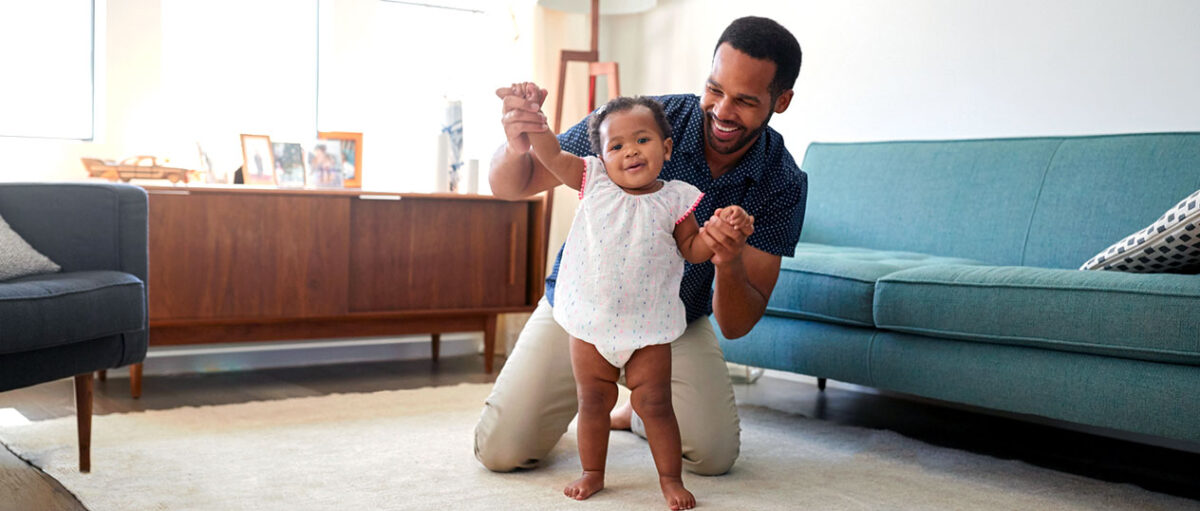You may not be able to 100% babyproof your home, but a babyproofing checklist definitely won’t hurt. The good news is that you really don’t need to worry about incorporating these changes until your baby can crawl. And, with our eight-step babyproofing checklist, you and your home will be more than up for the challenge when your little one starts exploring.
How to babyproof your home
- Wrap up renovations
- Store cleaning supplies out of reach
- Screw unstable furniture to the wall
- Cover outlets and cords
- Invest in knob covers for your stove
- Place corner guards on furniture
- Place non-slip pads under rugs
- Latch drawers and cabinets
1. Wrap up renovations
Welcoming a new addition into your family is a seriously busy period of life, so make sure you’ve wrapped up any home reno projects that you’ve been putting off beforehand. It’s not just a matter of time management—peeling paint, uneven floors, and more common fixer-upper problems could all be hazardous for children.
2. Store cleaning supplies out of reach
Raise your hand if the cabinet under the kitchen sink is your go-to cleaning supply storage space. We get it, but it’s not the safest location when you have toddlers on the move. We recommend choosing cabinets that are both higher off the ground and completely closable (open shelving might be in, but not in this babyproof house). This goes for any items that could be hazardous if your baby is exposed to them, from laundry supplies to medicine to toiletries.
3. Screw unstable furniture to the wall
Your little one will be learning to stand by pulling themselves up with furniture, so you need to make sure that furniture is stable. That means actually screwing that tall bookshelf into the wall at the top like the instruction manual told you to. If you’ve got chairs or other furniture with wheels, make sure the wheels lock if you’re unable to take them off entirely.
4. Cover outlets and cords
No babyproofing checklist would be complete without covering your electrical outlets. Outlet covers are fairly easy and inexpensive to find—just make sure you don’t forget any outlets tucked away out of sight. You’ll also want to store cords for chargers, appliances, and other devices out of reach from curious hands (and teeth).
5. Invest in knob covers for your stove
The last thing you want is for your baby to turn your stovetop burners on by accident. Or on purpose, for that matter. Stove knob covers may be a bit more challenging to find than outlet covers, but the peace of mind you get as a result will be well worth the extra effort.
6. Place corner guards on furniture
Falling is an inevitable part of learning to walk. So, it’s a good idea to cover any sharp edges with corner guards as part of your babyproofing process. Even if your baby isn’t at the mobile stage yet, you may want to consider corner guards for furniture near the changing table, crib, and anywhere else you’ll be frequently picking up and putting them down. To be clear, we think you’re going to be amazing as a parent and will absolutely not drop your baby. But, sometimes the best sleep comes from knowing you’ve prepared for the worst.
7. Place non-slip pads under rugs
From toddlers swaying unsteadily as they find their, well, legs in general to late-night rocking and pacing to coax the semblance of a regular sleep schedule, there are a lot of reasons you’ll want non-slip pads under your rugs. Tripping hazards are no joke when you’ve got a baby in your arms. And on a less serious note, it keeps your rugs looking neater. That’s one less thing to worry about on the adventure of parenting.
8. Latch drawers and cabinets
In an ideal world, we would store everything that posed a threat to babies out of their reach. But you only have so many cabinets, and the list of things that could potentially be problematic if a little one got their hands on it is essentially infinite. Props to toddlers for their ability to see the potential in objects beyond their intended purpose—never change! But for the sake of your sanity, we’d recommend installing latches on cabinets and drawers that are within tiny arm’s reach.
Is there anything else I should add to my babyproofing checklist?
You’ve probably noticed by now that a lot of people have a lot of thoughts about how you should raise your kid. While there are some good universal safety measures as we just went over, ultimately it’s your decision when it comes to how to babyproof your home. Your babyproofing checklist might look very different from ours, and that’s ok! If you tried to do everything everyone recommended, you’d go crazy. Do what you feel comfortable with and capable of, and the rest will come naturally. You’ve got this.
Babyproofing can feel overwhelming, but a good babyproofing checklist helps take some of the stress out of it.





